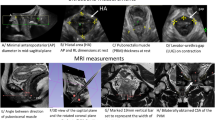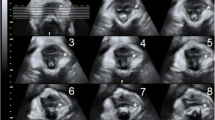Abstract
Introduction and hypothesis
The aim was to compare constriction of the levator hiatus (LH) and reduction of pelvic floor muscle (PFM) length during instruction of the Paula method (contraction of ring musculature of the mouth) and contraction of the PFM.
Methods
Seventeen pregnant or postpartum women, mean age 28.6 (range 20–35) participated. A Voluson E8 ultrasound machine with 4–8 MHz curved array 3D/4D transducer (RAB 4-7l/obstetric) was used. Measurements were performed in the axial plane of minimal hiatal dimensions. Muscle length was calculated as circumference of the LH minus the suprapubic arch. Differences between groups were analyzed using Wilcoxon signed rank test. Significance level was set to 0.05.
Results
There was a significant reduction of the LH area (p < 0.001) and muscle length (p < 0.001) during PFM contraction, but not during contraction according to the Paula method, p = 0.51 and p = 0.31, respectively.
Conclusions
The Paula method did not facilitate PFM contraction.

Similar content being viewed by others
Abbreviations
- LH:
-
Levator hiatus
- PB:
-
Pubic bone
- PFM:
-
Pelvic floor muscles
- PFMT:
-
Pelvic floor muscle training
- RCT:
-
Randomized controlled trial
- SUI:
-
Stress urinary incontinence
References
Kegel AH (1948) Progressive resistance exercise in the functional restoration of the perineal muscles. Am J Obstet Gynecol 56:238–249
Hay-Smith J, Dumoulin C (2006) Pelvic floor muscle training versus no treatment, or inactive control treatments, for urinary incontinence in women. The Cochrane Database Syst Rev 25: Issue 1
Hay-Smith J, Berghmans B, Burgio K, Dumoulin C., Hagen S, Moore K et al (2009) Adult conservative management. In: Abrams P, Cardozo L, Khoury S, Wein A (Editors): Incontinence. 4th International Consultation on Incontinence (4th Edition). Health Publication Ltd:1025–1120
Bø K (2007) Pelvic floor muscle training for stress urinary incontinence. In: Bø K, Berghmans B, Mørkved S, Van Kampen M (eds) Evidence based physical therapy for the pelvic floor: bridging science and clinical practice. Elsevier Ltd, Churchill Livingstone, pp 171–187
Yom-Tov S, Golani I (1993) Oscillators in the human body and circular-muscle gymnastics. Med Hypotheses 14(2):118–122
Liebergall-Wischnitzer M, Hochner-Celnikier D, Lavy Y, Manor O, Arbel R, Paltiel O (2005) Paula method of circular muscle exercises for urinary stress incontinence—a clinical trial. Int Urogynecol J 16:345–351
DeLancey JO (1994) The anatomy of the pelvic floor. Curr Opin Obstet Gynecol 6(4):313–316
Thompson JA, O’sullivan PB, Briffa K, Neumann P, Court S (2005) Assessment of pelvic floor movement using transabdominal and transperineal ultrasound. Int Urogynecol J Pelvic Floor Dysfunct 16(4):285–292
Brækken IH, Majida M, Engh ME, Bø K (2009) Test–retest reliability of pelvic floor muscle contraction measured by 4D ultrasound. Neurourol Urodyn 28:68–73
Guaderrama NM, Liu J, Nager CW, Pretorius DH, Sheean G, Kassab G et al (2005) Evidence for the innervation of pelvic floor muscles by the pudendal nerve. Obstet Gynecol 106(4):774–781
Benvenuti F, Caputo GM, Bandinelli S, Mayer F, Biagini C, Somavilla A (1987) Reeducative treatment of female genuine stress incontinence. Am J Phys Med 66(4):155–168
Bø K, Larsen S, Oseid S, Kvarstein B, Hagen R, Jørgensen J (1988) Knowledge about and ability to correct pelvic floor muscle exercises in women with urinary stress incontinence. Neurourol Urodyn 7(3):261–262
Bump R, Hurt WG, Fantl JA, Wyman JF (1991) Assessment of Kegel exercise performance after brief verbal instruction. Am J Obstet Gynecol 165:322–329
Bø K, Brækken IH, Majida M, Engh ME (2009) Constriction of the levator hiatus during instruction of pelvic floor or transversus abdominis contraction: a 4D ultrasound study. Int Urogynecol J 20:27–32
Bø K, Kvarstein B, Hagen R et al (1990) Pelvic floor muscle exercise for the treatment of female stress urinary incontinence, I: reliability of vaginal pressure measurements of pelvic floor muscle strength. Neurourol Urodyn 9:471–477
Bø K, Kvarstein B, Hagen R et al (1990) Pelvic floor muscle exercise for the treatment of female stress urinary incontinence, II: validity of vaginal pressure measurements of pelvic floor muscle strength and the necessity of supplementary methods for control of correct contraction. Neurourol Urodyn 9:479–487
Bø K (1992) Pressure measurements during pelvic floor muscle contractions: the effect of different positions of the vaginal measuring device. Neurourol Urodyn 11:107–113
Braekken IH, Majida M, Ellstrøm Engh M, Holme IM, Bø K (2009) Pelvic floor function is independently associated with pelvic organ prolapse. BJOG 116(13):1706–1714
Dietz H, Shek K, Clarke B (2005) Biometry of the pubovisceral muscle and levator hiatus by three-dimensional pelvic floor ultrasound. Ultrasound Obstet Gynecol 25:580–585
Brækken IH, Majida M, Engh ME, Dietz HP, Umek W, Bø K (2008) Test–retest and intra-tester reliability of two-, three- and four dimensional perineal ultrasound of pelvic floor muscle anatomy and function. Int Urogynecol J 19:227–235
Majida M, Brækken IH, Umek W, Bø K, Benth JS, Engh ME (2009) Inter-observer repeatability of three- and four-dimensional perineal ultrasound of pelvic floor muscle anatomy and function. Ultrasound Obstet Gynecol 33(5):567–573
Majida M, Brækken IH, Bø K, Benth JS, Engh ME (2009) Validation of three dimentional perineal ultrasound and magnetic resonance imaging measurements of the pubovisceral muscle at rest. Ultrasound Obstet Gynecol (in press)
Brækken IH, Majida M, Engh ME, Bø K (2010) Morphological changes after pelvic floor muscle training mesaured by 3-dimensional ultrasonography. A randomized controlled trial. Obstet Gynecol 115, 2, part 1: 317–324
Bø K, Sherburn M, Allen T (2003) Transabdominal measurement of pelvic floor muscle activity when activated directly or via a transversus abdominis muscle contraction. Neurourol Urodyn 22:582–588
Baessler K, Junginger B (2010) Gymnastics for urinary incontinence—destroying the myth. Neurourol Urodyn 29(6):1052–1053
Folland JP, Williams AG (2007) The adaptations to strength training: morphological and neurological contributions to increased strength. Sports Med 37:145–168
Bø K, Aschehoug A (2007) Strength training. In: Bø K, Berghmans B, Mørkved S, Van Kampen M (eds) Evidence based physical therapy for the pelvic floor: bridging science and clinical practice. Elsevier Ltd, Churchill Livingstone, pp 119–131
Sapsford R (2004) Rehabilitation of pelvic floor muscles utilizing trunk stabilization. Man Ther 9:3–12
Savage AM (2005) Is lumbopelvic stability training (using the Pilates model) an effective treatment strategy for women with stress urinary incontinence? A review of the literature and report of a pilot study. Jass Chart Physiother Women’s Health 97:33–48
Miller JM, Ashton-Miller JA, DeLancey JOA (1998) Pelvic muscle precontraction can reduce cough-related urine loss in selected women with mild SUI. J Am Geriatr Soc 46:870–874
Bo K (2004) Pelvic floor muscle training is effective in treatment of female stress urinary incontinence, but how does it work? Int Urogynecol J Pelvic Floor Dysfunct 15:76–84
Acknowledgement
This study was supported financially by the Norwegian Research Council, Program for Clinical Research and Helse Sør-Øst.
Conflicts of interest
None.
Author information
Authors and Affiliations
Corresponding author
Rights and permissions
About this article
Cite this article
Bø, K., Hilde, G., Stær-Jensen, J. et al. Can the Paula method facilitate co-contraction of the pelvic floor muscles? A 4D ultrasound study. Int Urogynecol J 22, 671–676 (2011). https://doi.org/10.1007/s00192-010-1317-8
Received:
Accepted:
Published:
Issue Date:
DOI: https://doi.org/10.1007/s00192-010-1317-8




